All the solutions provided in McGraw Hill Math Grade 5 Answer Key PDF Chapter 3 Lesson 9 Place the First Digit will give you a clear idea of the concepts.
McGraw-Hill My Math Grade 5 Answer Key Chapter 3 Lesson 9 Place the First Digit
Math in My World
Example 1
Raven received 135 E-mails over 3 weeks. If she received the same number of E-mails each week, how many E-mails did she receive in the first week?
Find 135 ÷ 3.
Estimate 150 ÷ 3 = ____

1. Divide the hundreds.
There are not enough hundreds to divide into 3 groups. So, regroup 1 hundred and 3 tens as 13 tens.
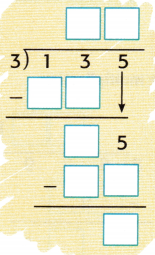
So, Raven received ____ E-mails in the first week.
Check for Reasonableness Compare to the estimate.
_____ ≈ 50
2. Divide the tens.
The first digit of the quotient is in the tens place.
3. Divide the ones.
Answer:
45
Estimate: 50
Explanation:
Divide the hundreds.
There are not enough hundreds to divide into 3 groups.
So, regroup 1 hundred and 3 tens as 13 tens.
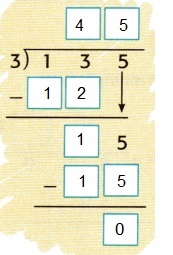
So, Raven received 45 E-mails in the first week.
Divide the tens.
The first digit of the quotient is in the tens place.
Divide the ones.
The symbol ≈ means about or almost equal to.
45 ≈ 50
Estimate 150 ÷ 3 = 50
Example 2
Find ![]() .
.
Estimate 7,000 ÷ 7 = ____
1. Divide the hundreds.
There are not enough thousands to divide into 7 groups. So, regroup 6 thousands and 7 hundreds as 67 hundreds.
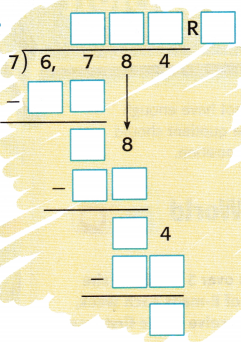
2. Divide the tens.
The first digit of the quotient is in the hundreds place.
3. Divide the ones.
So, 6,784 ÷ 7 = ____
Check for Reasonableness Compare to the estimate.
Estimate 7,000 ÷ 7 = 1000
_____ ≈ _____
Answer:
Quotient = 969
Remainder = 4
Estimate: 1000
Explanation:
Divide the hundreds.
There are not enough thousands to divide into 7 groups.
So, regroup 6 thousands and 7 hundreds as 67 hundreds.
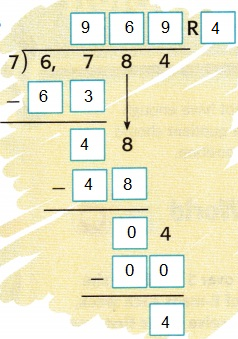
Divide the tens.
The first digit of the quotient is in the hundreds place.
Divide the ones.
So, 6,784 ÷ 7 = 969
Remainder = 4
Check for Reasonableness Compare to the estimate.
Estimate 7,000 ÷ 7 = 1000
969 ≈ 1000
Talk Math
You want to find 510 ÷ 6. Tell how you know where to place the quotient’s first digit.
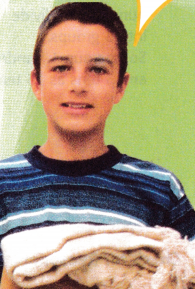
Answer:
510 ÷ 6 = 85
Explanation:
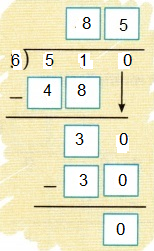
We use place value to place the first digit.
If the first digit is less than the divisor, then the first digit of the quotient will be in the hundreds place.
If the first digit is greater than or equal to the divisor, then the first digit of the quotient will be in the thousands place.
Guided Practice
Divide. Check your answer using multiplication.
Question 1.

Answer:

Explanation:
Divide the hundreds.
There are not enough hundreds to divide into 5 groups.
So, regroup 4 hundred and 3 tens as 43 tens.
Divide the tens.
The first digit of the quotient is in the tens place.
Divide the ones.
87 x 5 = 435
Question 2.

Answer:

Explanation:
Divide the hundreds.
There are not enough thousands to divide into 8 groups.
So, regroup 6 thousands and 2 hundreds as 62 hundreds.
Divide the tens.
The first digit of the quotient is in the hundreds place.
Divide the ones.
So, 629 ÷ 8 = 78
Remainder = 5
Check: 78 x 8 = 624
Add the remainder to the quotient.
624 + 5 = 629
Independent Practice
Divide.
Question 3.
![]()
Answer:
96
Explanation:
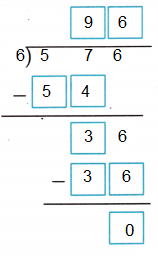
Divide the hundreds.
There are not enough hundreds to divide into 6 groups.
So, regroup 5 hundred and 7 tens as 57 tens.
Divide the tens.
The first digit of the quotient is in the tens place.
Divide the ones.
Question 4.
![]()
Answer:
617
Explanation:
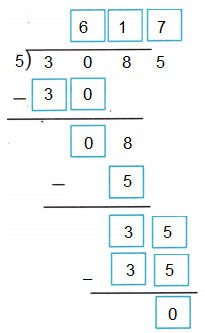
Divide the thousands.
There are not enough thousands to divide into 5 groups.
So, regroup 3 thousand and 0 tens as 30 tens.
Divide the hundreds.
The first digit of the quotient is in the hundreds place.
Divide the tens and ones.
Question 5.
![]()
Answer:
64
Explanation:
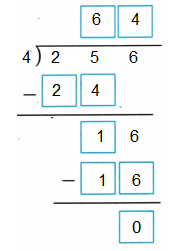
Divide the hundreds.
There are not enough hundreds to divide into 6 groups.
So, regroup 5 hundred and 7 tens as 57 tens.
Divide the tens.
The first digit of the quotient is in the tens place.
Divide the ones.
Question 6.
![]()
Answer:
Quotient = 754
Remainder = 3
Estimate: 755
Explanation:
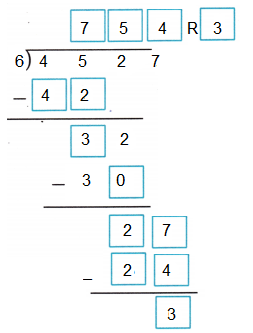
Divide the thousands.
There are not enough thousands to divide into 6 groups.
So, regroup 4 thousands and 5 tens as 45 tens.
Divide the hundreds.
The first digit of the quotient is in the hundreds place.
Divide the tens and ones.
Check: 754 x 6 = 4524
Remainder is 3.
Add the quotient and remainder.
4524 + 3 = 4527
Estimate: 4530 ÷ 6 = 755
Question 7.
![]()
Answer:
Quotient is 54.
Remainder is 1.
Estimate: 55
Explanation:

Divide the hundreds.
There are not enough hundreds to divide into 4 groups.
So, regroup25 hundred and 1 tens as 21 tens.
Divide the tens.
The first digit of the quotient is in the tens place.
Divide the ones.
So, 217 ÷ 4 = 54
Remainder = 1
Check: 54 x 4 = 216
Add the remainder to the quotient.
216 + 1 = 217
Estimate: 55
220 ÷ 4 = 55
Question 8.
![]()
Answer:
Quotient is 68.
Remainder is 2.
Estimate: 70
Explanation:
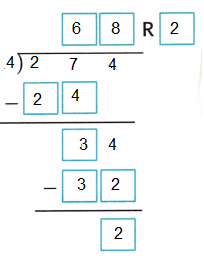
Divide the hundreds.
There are not enough hundreds to divide into 4 groups.
So, regroup 2 hundred and 7 tens as 27 tens.
Divide the tens.
The first digit of the quotient is in the tens place.
Divide the ones.
So, 274 ÷ 4 = 68
Remainder = 2
Check: 68 x 4 = 272
Add the remainder to the quotient.
272 + 2 = 274
280 ÷ 4 = 70
Question 9.
2,181 ÷ 3 = ____
Answer:
727
Explanation:
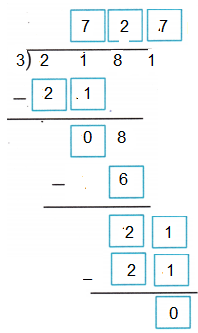
Divide the thousands.
There are not enough thousands to divide into 3 groups.
So, regroup 2 thousand and 1 tens as 21 tens.
Divide the hundreds.
The first digit of the quotient is in the hundreds place.
Divide the tens and ones.
Check: 717 x 3 = 2181
Question 10.
108 ÷ 9 = ____
Answer:
12
Explanation:
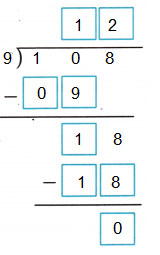
Divide the hundreds.
There are not enough hundreds to divide into 9 groups.
So, regroup 1 hundred and 0 tens as 10 tens.
Divide the tens.
The first digit of the quotient is in the tens place.
Divide the ones.
Question 11.
3,417 ÷ 4 = ___
Answer:
Quotient = 854
Remainder = 1
Estimate: 855
Explanation:
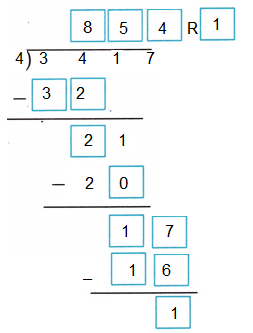
Divide the thousands.
There are not enough thousands to divide into 4 groups.
So, regroup 3 thousand and 4 tens as 34 tens.
Divide the hundreds.
The first digit of the quotient is in the hundreds place.
Divide the tens and ones.
Check: 854 x 4 = 3416
Remainder is 1.
Add the quotient and remainder.
3416 + 1 = 3417
Estimate: 3420 ÷ 4 = 855
Algebra Find the unknown number in each equation.
Question 12.
232 ÷ 8 = q
q = ____
Answer:
q = 29
Explanation:
Divide the hundreds.
There are not enough hundreds to divide into 8 groups.
So, regroup 2 hundred and 3 tens as 23 tens.
Divide the tens.
The first digit of the quotient is in the tens place.
Divide the ones.
232 ÷ 8 = 29
Check: 29 x 8 = 232
Question 13.
324 ÷ 9 = s
s = ____
Answer:
s = 36
Explanation:
Divide the hundreds.
There are not enough hundreds to divide into 9 groups.
So, regroup 3 hundred and 2 tens as 32 tens.
Divide the tens.
The first digit of the quotient is in the tens place.
Divide the ones.
324 ÷ 9 = 36
Check: 36 x 9 = 324
Question 14.
192 ÷ 4 = y
y = ____
Answer:
y = 48
Explanation:
Divide the hundreds.
There are not enough hundreds to divide into 4 groups.
So, regroup 1 hundred and 9 tens as 19 tens.
Divide the tens.
The first digit of the quotient is in the tens place.
Divide the ones.
192 ÷ 4 = 48
Check: 48 x 4 = 192
Problem Solving
Question 15.
There are 624 envelopes to be sorted into 8 different mail bags. If the same number of envelopes will be in each bag, how many envelopes will be in one bag?
Answer:
78 envelops.
Explanation:
There are 624 envelopes to be sorted into 8 different mail bags.
Number of envelopes in one bag,
624 ÷ 8 = 78
Check: 78 x 8 = 624
Question 16.
Mathematical PRACTICE 2 Use Symbols There are 594 people standing in line to see a movie premiere. The movie is playing in 6 theaters. If the same number of people will see the movie in each theater, how many people will be in each theater? Write an equation to find the unknown. Then find the unknown.
Answer:
594 ÷ 6 = p
p = 99
Explanation:
There are 594 people standing in line to see a movie premiere.
The movie is playing in 6 theaters.
594 ÷ 6 = 99
Check: 99 x 6 = 594
So, unknown (p) = 99
Question 17.
The Environmental Club is having a trash pickup day. There are 130 people signed up to help. For the trash pickup day, they will work in groups of 4 people. No more than 4 people can join a group. How many groups are there? Explain how you interpreted the remainder.
Answer:
Explanation:
130 people signed up to help the environmental club.
they will work in groups of 4 people.
No more than 4 people can join a group.
Number of groups 130 ÷ 4
Divided the hundreds.
There no sufficient hundreds to group.
So, add 1 hundred to 3 tens as 13 tens.
Divided ones.
130 ÷ 4 = 32 groups.
Remainder = 2
Check: 32 x 4 = 128
Add remainder to quotient,
128 + 2 = 130
HOT Problems
Question 18.
Mathematical PRACTICE 2 Use Number Sense Can you determine the number of digits in the quotient of 637 ÷ 7 without dividing? Explain.
Answer:
Yes, 2 digits.
Explanation:
As the hundreds are not sufficient to divided,
move to tens as 63 then divided.
63 ÷ 7 = 9
Divided ones.
7 ÷ 7 = 1
So, 637 ÷ 7 = 91
Question 19.
? Building on the Essential Question How can I know where to place the first digit of a quotient?
Answer:
Use place value to place the first digit.
Look at the first digit.
If the first digit is less than the divisor, then the first digit of the quotient will be in the hundreds place.
If the first digit is greater than or equal to the divisor, then the first digit of the quotient will be in the thousands place.
Explanation:
For example;

Divide the hundreds.
There are not enough hundreds to divide into 9 groups.
So, regroup 1 hundred and 0 tens as 10 tens.
Divide the tens.
The first digit of the quotient is in the tens place.
Divide the ones.
McGraw Hill My Math Grade 5 Chapter 3 Lesson 9 My Homework Answer Key
Practice
Divide.
Question 1.
![]()
Answer:
81
Explanation:
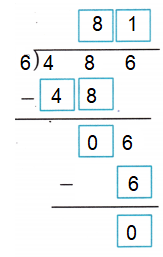
Divide the hundreds.
There are not enough hundreds to divide into 6 groups.
So, regroup 4 hundred and 8 tens as 48 tens.
Divide the tens.
The first digit of the quotient is in the tens place.
Divide the ones.
486 ÷ 6 = 81
Check: 81 x 6 = 486
Question 2.
![]()
Answer:
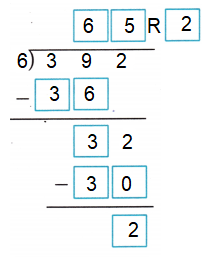
Explanation:
Divide the hundreds.
There are not enough hundreds to divide into 6 groups.
So, regroup 3 hundred and 9 tens as 39 tens.
Divide the tens.
The first digit of the quotient is in the tens place.
Divide the ones.
392 ÷ 6 = 65
Remainder = 2
Check: 65 x 6 = 390
Add the remainder to quotient.
390 + 2 = 392
Question 3.
5,920 ÷ 6 = ____
Answer:
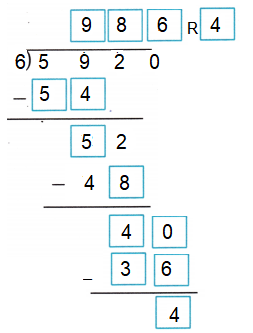
Explanation:
Divide the thousands.
There are not enough thousands to divide into 6 groups.
So, regroup 5 thousand and 9 tens as 59 tens.
Divide the hundreds.
The first digit of the quotient is in the hundreds place.
Divide the tens and ones.
Check: 986 x 6 = 5916
Remainder is 4.
Add the quotient and remainder.
5916 + 4 = 5920
Problem Solving
Question 4.
The phone company needs 420 poles to repair the telephone lines. Each truck holds 6 poles. How many trucks will they need?
Answer:
70 trucks.
Explanation:
The phone company needs 420 poles to repair the telephone lines.
Each truck holds 6 poles.
Number of trucks they need,
420 ÷ 6 = 70
Check: 70 x 6 = 420 poles.
Question 5.
The festival committee has $1,544 to spend on pies for the pie-eating contest. If each pie costs $8, how many pies can the committee purchase?
Answer:
193 pies.
Explanation:
The festival committee has $1,544 to spend on pies for the pie-eating contest.
If each pie costs $8,
Number of pies the committee purchase,
1544 ÷ 8 = 193
Check: 193 x 8 = 1544
Question 6.
Algebra A group of 273 people take a canoe trip. Each canoe holds 3 people. How many canoes will the group need? Write an equation to find the unknown?
Answer:
273 ÷ 3 = c
c = 91 canoes.
Explanation:
A group of 273 people take a canoe trip.
Each canoe holds 3 people.
Number of canoes the group need,
273 ÷ 3 = c
c = 91
Check: 91 x 3 = 273 people.
Hot Problems
Question 7.
Mathematical PRACTICE 3 Which One Doesn’t Belong? Circle the expression that does not have a two-digit quotient.
519 ÷ 6 915 ÷ 7 439 ÷ 7 812 ÷ 9
Answer:

Explanation:
Expect 915 ÷ 7 all other divisions have 2 digit quotient,
because the divisor is less than the dividend.
519 ÷ 6 = 86.5
915 ÷ 7 = 130.7
439 ÷ 7 = 62.7
812 ÷ 9 = 90.2
Test Practice
Question 8.
A glass company ships 470 glass ornaments. Each box holds 5 ornaments. How many boxes will the company need?
A. 84 boxes
B. 92 boxes
C. 93 boxes
D. 94 boxes
Answer:
Option(D)
Explanation:
A glass company ships 470 glass ornaments.
Each box holds 5 ornaments.
Number of boxes will the company need,
470 ÷ 5 = 94
Check: 94 x 5 = 470